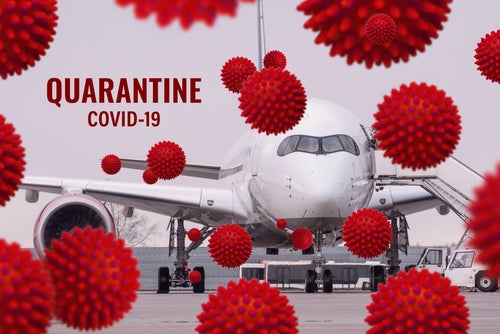
Legal firm White & Case LLP considers some new developments in aircraft financing on the back of Covid-19.
-O-
The Covid-19 viral pandemic and accompanying government travel restrictions have dramatically impacted the global aviation industry.
With millions fewer passengers than normal during the first quarter of 2020, airlines are scrambling to cut costs and reduce flights.
Meanwhile, industry experts project that industry revenues could decline as much as 70% in April and May.
During ordinary economic down cycles, aviation companies often adjust by taking measures to preserve their liquidity, manage debt covenants, refinance prior transactions and restructure operations.
How well do you really know your competitors?
Access the most comprehensive Company Profiles on the market, powered by GlobalData. Save hours of research. Gain competitive edge.

Thank you!
Your download email will arrive shortly
Not ready to buy yet? Download a free sample
We are confident about the unique quality of our Company Profiles. However, we want you to make the most beneficial decision for your business, so we offer a free sample that you can download by submitting the below form
By GlobalDataBut dramatic challenges such as the recent Covid-19 viral pandemic call for creative solutions.
Alongside the typical operational and financial adjustments that the aviation industry may employ in difficult economic times — and which many businesses may still find advisable — these are some new ideas that may be useful for the industry to discuss in an unprecedented crisis.
1. Opportunities in sale-leaseback transactions
Right now, well-positioned lessors and other investors may be able to purchase assets at attractive prices while providing the much-needed liquidity to aviation operators through sale-leaseback transactions.
The current market offers opportunities for lessors to add more aircraft to their portfolios at lower than usual costs, for those willing to assume the risks of default and nonpayment.
Lessors with available capital to invest could offer liquidity to operators by purchasing their aircraft assets and then leasing them back to operators through short-term or other structured leases.
In addition, private equity and hedge fund investors may seek to capitalize on the potential low costs of aircraft assets; lessors could then form joint ventures with these investors to buy aircraft assets and/or manage new aviation portfolios for them.
Of course, any purchase will have to assume the heightened risks of default in the near-term and potential down-time during which the newly purchased assets remain grounded.
2. Examining MAE and MAC clauses
Aviation agreements may specify that transaction closings and loan drawdowns will not take place if one party has suffered a “material adverse effect” (MAE) or “material adverse change” (MAC).
Until now, most transaction documents and case law generally have not directly addressed whether pandemics such as Covid-19 constitute a MAC or MAE.
Unless a specific provision includes a pandemic in the MAC/MAE definition, lessees and borrowers may find it difficult to argue that their creditors or lessors assumed pandemic risk, although this could depend on the facts of the particular case, including if one party had contractually agreed to take the risk of “general economic conditions,” “natural disasters” and “national emergencies.”
Recently, transaction documents have begun specifically allocating pandemic or Covid-19 risk in their MAE/MAC definitions, and this trend is likely to continue.
3. Consider a limited aviation automatic stay
US airlines have petitioned for more than US$50bn of US government assistance, including a mix of direct aid and loan guarantees.
Other airlines are in the process of appealing to their national governments for similar aid. The International Air Transport Association predicts that the global airline industry could need up to US$200bn in government assistance.
Another option for the industry to consider would be a limited “automatic stay,” whereby the government could shield the aviation industry from creditor actions and other enforcement consequences while airline travel remains limited or restricted due to the pandemic.
Having imposed regulatory travel restrictions that prevented airlines from generating revenues through ordinary carrier routes, governments have left the airline industry to the mercy of their creditors.
So instead of a traditional “bail-out,” governments could impose a temporary automatic stay against enforcement. Such an approach will likely require mandatory loan restructurings throughout the aviation industry, government support to the banking community and multilateral adherence.
While the legal issues involved in this approach are complex and worthy of a deeper analysis, some recent efforts serve as parallel examples.
For example, UN Security Council Resolution 1483 implemented an automatic stay globally on the enforcement of creditors’ rights to use litigation to collect on Iraq’s unpaid sovereign debt.
Recently in the US, the 2003 Servicemembers’ Civil Relief Act (SCRA) was enacted to shield active duty US service members from default judgments, among other legal consequences, and the 2009 Home Affordable Modification Program (HAMP) was implemented to incentivize restructuring individual home mortgages following the subprime mortgage crisis.
A similar regulatory solution could temporarily shield the aviation industry and thus lessen the urgent need for multi-billion dollar aid packages.
Keeping an eye on the medium-term horizon
In light of the current deep uncertainty, it is worth reviewing what our aviation finance survey of senior executive – conducted at the end of 2019, just before this crisis began – showed about the market fundamentals and mood.
Without knowing exactly what may lie farther ahead on the horizon, this data highlights trends that may reemerge, including geographic nuances, once airline travel begins to rebound.








